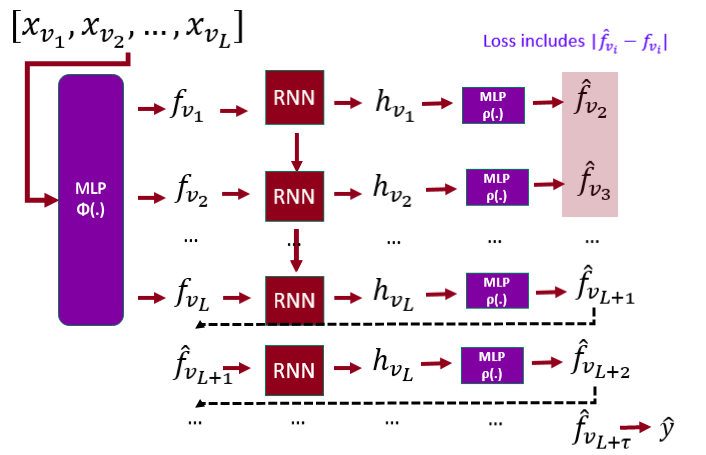Computational models that forecast the progression of Alzheimer’s disease at the patient level are extremely useful tools for identifying high risk cohorts for early intervention and treatment planning. The state-of-the-art work in this area proposes models that forecast by using latent representations extracted from the longitudinal data across multiple modalities, including volumetric information extracted from medical scans and demographic info. These models incorporate the time horizon, which is the amount of time between the last recorded visit and the future visit, by directly concatenating a representation of it to the latent data representation. In this paper, we present a model which generates a sequence of latent representations of the patient status across the time horizon, providing more informative modeling of the temporal relationships between the patient’s history and future visits. Our proposed model outperforms the baseline in terms of forecasting accuracy and F1 score.
We present the F1-score over maximum forecasting horizon for each level of data availability:
We used data from the TADPOLE challenge. Specifically, we used the TADPOLE_D1_D2.csv file. Download that file and save it in the directory data/.
Python version used = 3.6.5 All library requirements are in requirements.txt
- Create an environment with the correct version of python.
- Install all dependencies by running the following command:
python -r requirements.txt
In TADPOLE_D1_D2.csv file, each row contains the data corresponding to a single visit of a patient.
For each visit of a patient, we extract the following features:
- Image Features: 692 columns representing MRI biomarkers, which can be found in the columns containing UCSFFSX (cross-sectional) and UCSFFSL (longitudinal).
- Cognitive Assessment Features: ADAS11, CDRSB, MMSE, RAVLT_immediate
- Structured Covariate Features: AGE, PTGENDER, APOE4
The experiment parameters can be set using the configuration file present in the folder configs/. Please refer to the default config file, configs/config.yaml, for details about the model parameters.
The main.py file in the scripts/ directory contains the code that does the following:
- Creates an experiment directory in the outputs/ folder.
- Creates a pickle object for the data named data.pickle (which is stored in the data/ directory), that stores the features extracted from the TADPOLE_D1_D2.csv file in a structured manner, to be later used for training. This will be a one-time process, and the data.pickle file will be loaded for all future experiments.
- Trains the model.
- Evaluates the model.
Thus, the model can be trained by doing the following:
1. Set train_model = True in config.yaml.
2. Run the command:
python main.py --config=../configs/config.yaml
The config file requires an ID to be assigned to the present experiment. This is used to create a folder in the outputs/ directory, which stores all the checkpoints, logs and results of that experiment.
After training, the model weights are saved in the directory
outputs/<exp_id>/checkpoints/.
The loss graphs are stored in the directory
outputs/<exp_id>/logs/.
The evaluation confusion matrices are stored in the directory
outputs/<exp_id>/results/.
The model can be evaluated on the train, validation, and test datasets by
doing the following:
1. Set train_model = False and test_model = True in config.yaml.
2. Run the command:
python main.py --config=../configs/config.yaml
The results are stored in the directory outputs/<exp_id>/results/.
We uploaded the experiment folder flare_pretrained/ with the best results here. The model
can be initialized with these pretrained weights by setting
model.load_model: '../outputs/flare_pretrained/checkpoints/model.pth'
in the config file.

